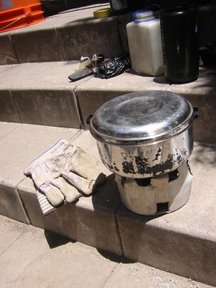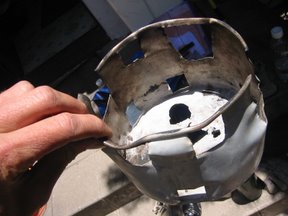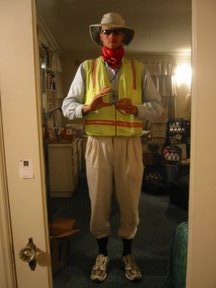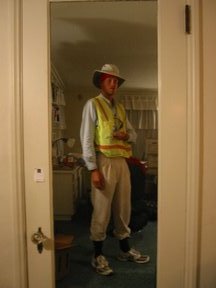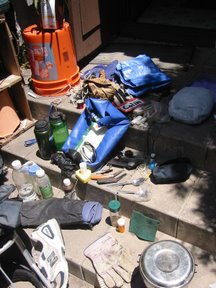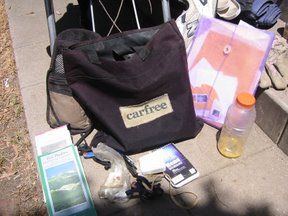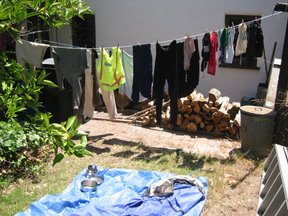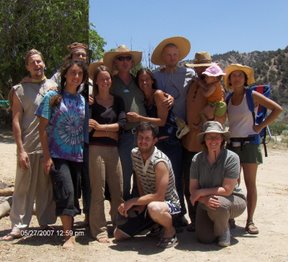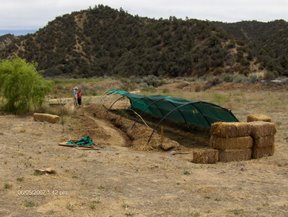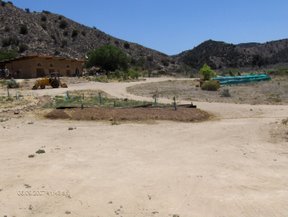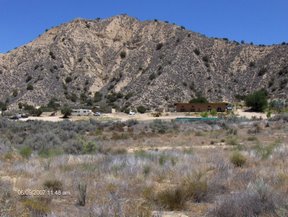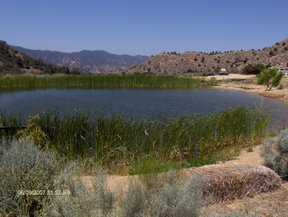The Walking Sangha & carfree camp: we free people to walk to centers of earthcare and peoplecare (a proposal for a skill-sharing community)The Walking Sangha I am a part of in Los Padres National Forest supports walkers heading to Quail Springs Permaculture Farm and to other sites between there and Ojai and Santa Barbara. We make our life in the forest itself a practice, keeping time for silence, for trail work or walking, and for sharing. We also help Quail Springs care for their land and community. At least two thirds of our time is spent in roadless areas.
Added by colin #442 on 2007-06-23. Last modified 2007-07-06 20:57. Originally created 2007-06-23. F0 License: Attribution
|
|
for us
Abbreviations:
Contents
| 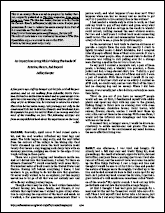 View PDF Version View OpenOffice.org 2.0 Format This .pdf contains peace and dpmpracticing as well. |
I am not sure I will do any of this.
When
When: The first trip will be shortly after the green anarchy gathering (in the California Sierra Nevada from Friday 7/27 - Sunday 8/5 in 2007). I will spend two weeks in the forest at that time, from Monday 8/6 - Monday 8/20. Either during those two weeks, or immediately after (8/20 - 8/27), we could accompany the first group of hikers from Santa Barbara or Ojai to Quail Springs.
Sangha
Here, sangha refers to "community of practitioners," not necessarily to practitioners of buddhism. The work of Vietnamese buddhist Thich Nhat Hanh is an inspiration for this proposal. From Practicing at Deer Park Monastery:
Practicing as a SanghaWe have come to practice together as a community. We do not encourage isolated practices or solo retreats. We are part of a body--the Sangha body, the community. Our practice is that of inter-being. Our joy and our sorrow contribute to the collective joy and sorrow of the community. Our transformation and realization on the path can nourish us all. The community can also be of great support if our heart is open. Our insight and development must be realized in the community. There is no individual, separated happiness.
I have been doing solo retreats by default on my walks. It costs at least $25 per day to visit TNH's sangha. We can have our own in the forest, and perhaps spend as little as $30 per week.
This idea was developed partly because visiting Deer Park Monastery is expensive and because it could be a while before I could visit there for two weeks at a time due to events they have scheduled. Even so, I could learn a lot from a long-term visit to Deer Park, and I might remain in San Diego until that visit becomes possible. TNH encourages everyone to help build a happy sangha. These are some ideas for a way to do that in the forest.
Practice
Here, practice refers to things we do every day or every so often that help us have a better life. For example, at Quail Springs, they share what they are thankful for before meals. During part of our time in the forest we can share practices that help us.
How to participate:
- If you'd like to join the group walk to Quail Springs from either Ojai (40 miles) or Santa Barbara (45-50 miles), email me saying if you have requests or restrictions about where you start from or when you can walk (between 8/6 and 8/27). Put "Walk to QS" in your email subject--see bottom of page for email link, or call 619 582 7583 before 7/23. You might also try calling Cindy at Quail Springs at 805 886 7239, especially if you can't get through to me.
- If you want to be a longer-term part of a walking sangha (what I may like most), let's give it a try.
Note: I'm saying "walk," but these routes start at or near sea level and may go over 6,000 feet and also repeatedly up and down as we pass from one creek's watershed to the next. Many places are hot and dry, and some trails are very overgrown or cut by gravel slides down steep slopes. There are rattlesnakes, bears, mountain lions, coyotes, and deer that will snort at you. I am not a trained wilderness first responder, nor do I carry a cell phone or radio.
Warm-ups & Preparation
We will organize a warm-up trip for people who want to prepare to do the full hike. Starting in Santa Barbara, Ojai, or QS, we will go out for at least Friday and Saturday night.
It might be best that any participant would have recently gone on a three-night hike of about 20 miles, going 8-10 miles on one of the days. However, I want to help everyone go slow in and spend time in the forest, so let me know what your experience is and what you want to do.
Below I have pictures of the equipment I carry.
Mission
Our mission may be:
- To do what contributes to long-term peace of mind within ourselves and others.
- To maintain a schedule supportive of sharing our life practices and the practice of being community.
- To help people use, develop, and maintain walking trails and other motor- and wheel-free routes to places where earthcare and peoplecare are practiced and taught.
- To spend two thirds of our time in roadless areas, learning from each other and from the land.
Behind this vision are my desires:
(1) To avoid the effects of others' car and machine use and of an infrastructure and lifestyle built around that use.
(2) To live with and learn from others in person, rather than with their printed words or electronic transmissions.
(3) To live close to the land, gathering or growing food, water, and energy and constructing tools from resources found in places I walk between.
(4) Not to pay rent with money, and not to do work for the purpose of making money, which should lead to a more integrated, community-based life.
(5) To have a healthy way of eating.
This is how the Walking Sangha may get started and what it may do:
--> I have already walked from Santa Barbara to Quail Springs (50 mi, five nights) and from Quail Springs to Ojai (40 mi, four nights), through Los Padres National Forest. There is interest among those who visit and who live at QS in also doing one of those walks.
--> I have benefited from studying buddhism, primarily through TNH, S.N. Goenka, and the nun, monks, and literature at Pine Mountain Buddhist Temple, which is only 15 miles from QS. Since 2002, I have also benefitted from doing the Ken Wilber-recommended ITP, a type of simple yoga, qi gung, relaxation, and affirmation practice intended to develop one's whole being. I learned how to walk primarily from Frank Cook, an itinerant herbalist, and also from Peace Pilgrim, Tom Elpel, Tom Brown Jr., my time in the Boy Scouts, (and the list goes on). My practice incorporates elements from these areas and others. See practice links for more information. I want to learn about and share in the practices and views which help you live too.
--> You may want to have company on a walk from Ojai or Santa Barbara to QS or Pine Mtn. Temple, and we can develop a routine good for all in the group.
--> From QS to Ojai, I practiced walking as if I had all the time in the world: Since I left QS, I have sat in the morning (or midday, so I could do the hardest hiking early in the day), and in the evening, usually for an hour each time, and on most days did my version of the ITP. I saw only one group (three people with five horses) on the trail--in other words, LPNF is a great place to be with one's self and with others and to develop a practice which consists of sitting still and quiet, of living away from machines, of learning about plants and animals, of doing meaningful work (many trails need maintenance), and of eating simply and not a lot (you only have what you carry or gather).
--> From Friday, July 27, to Sunday, August 5, 2007, is the green anarchy gathering in the Sierra Nevada of CA. I might find people interested in this idea there. We could walk part of the way back to QS.
--> Finance & Diet: Between trips in LPNF, we may be able to resupply either in SB, Ojai, or QS. I will be working out a good diet based partly on the work of Roy Walford (optimal nutrition per calorie). I believe our food costs could be $30/person/week or less. I think we could comfortably go two weeks without wanting to resupply (and longer as we learn more skills). If we are at or near QS, we may be able to do work for them and receive food we need. To cover equipment maintenance and cost, we would either need to bring in donations, or to take, perhaps as individuals, occasional work for money. Below I cover diet in more detail.
--> It might also be possible to establish a "carfree camp" on or near QS that did not have road access, where participants in and visitors to the Walking Sangha could reside and develop shelters and food systems primarily without the use of motors and distantly-imported materials. Or, at the least, we could camp and cook there and do work nearby that supports the land, or walk to downtown QS and do work there.
--> Plenty of time could be spent in LPNF doing simple trail work such as trimming brush.
--> The walking style and routine I might like in a group would at the least allow for an hour in the morning (or midday) and in the evening for me to keep sitting, and for an hour and a half to do the ITP exercises. At the most (only meditation devotees might appreciate the following), we would all be doing something like that, and we might maintain a "noble silence" from evening to morning, during part or all of the meals, and then have time during the day for sharing of practice techniques and knowledge. We could also make things very buddhist and follow something like the five mindfulness trainings of TNH.
--> Another avenue for finding participants would be Pine Mountain Temple and other buddhist sanghas, as well as notes in buddhist publications and websites. An advantage of the Walking Sangha is that its practice could have simplicity, closeness of community, and peaceful settings that sanghas with buildings, money, and nearness to many machines might not. We also do not need to strongly encourage donations (or require fees) from participants and visitors as we would all be carrying our supplies and covering our expenses.
--> We could also advertise on web listings of intentional communities, and on sites or through groups such as CraigsList, Sierra Club, and those having to do with green anarchy; humanistic psychology (e.g., Esalen); integral, new age, neo-indigenous, and neo-pagan practice; and primitive skills. We could offer a retreat environment that had a base practice of quiet hours in the morning (or midday) and evening, a time for sharing of views and individual and community practices, a time for meaningful work or for walking, and suggested practices for speaking, listening, eating, walking--along the lines of Deer Park Monastery's guidelines for practice. Within that buddhist framework, people with many different orientations and backgrounds could learn from each other.
What's the least I need to do to make some version of this happen?
(1) If I tell Quail Springs I'm planning to return by walking, they can announce it in their newsletter and we can find a date and a route when others would walk with me as well. I could probably fit in my practice on that sort of walk, and maybe we'd do some new route-finding.
A carfree camp/hermitage at QS?
(2) I could return to QS whether or not anyone would walk with me that time, and do some new route-finding/making I have in mind. I could see if QS would assist me in living on a car-inaccessible area for a month or two: I might find some way of doing work they would value in exchange for providing some food for that time, or I would give them money to help cover the costs of the food I would take. This way I could experience sort of being a hermit (for better or worse), while having attachment to and opportunity to visit their community, when I wanted to. In that time, I would become a different person--this idea might not matter anymore. Perhaps others would want to participate in the carfree camp, and we could share practices, and form a sub-community.
Why I might not want to stay in downtown QS
Not at peace. . .
Reasons I may not want to be a normal QS intern: I'm not yet at peace with all of their practices, projects, and choices. I have trouble getting myself to work for others unless it is work I clearly feel the value of and also feel effective doing. I may want some distance and more perspective before committing life energy there. The value of some work is clear to me: erosion control, for example. Having done that, if we walked away, the land would be better for it. Even so, I might not like working with or for others on a project I agree has value if I do not feel good with the manner of working (my own slowness and frequent lack of energy might be a factor here, but I'm not sure whether that is physical or motivational).
Too much good food
I have trouble dealing with the abundant, good-quality food they bring in--I just tend to eat too much then. Off, away from that, I might be more at peace, and then more able to develop self-control for the times I am around abundant, diverse good food. Cooking community dinners also seemed unnecessarily difficult for me--I guess I'd rather be in camp cooking just my own meal on my own schedule, not wondering whether others would eat what I made or wondering how I'd deal with what others might make and when I should be ready to eat.
It is possible that returning after having identified these difficult areas for me I could find good solutions.
Lack of ease with social interaction
In addition, some aspects of daily interaction were hard for me: I tended to let myself get disturbed by their thanksgiving practice (nominally: sharing what we are thankful for before we eat or before a meeting), and by simple things such as many people asking me how I was doing, or even when people expressed appreciation for me.
Since I have left, however, I have noticed I am more likely to express appreciation to others, and that doing so is a good thing. Even though I'm exploring my issues and lack of contentness in this writing, I believe there is wisdom in the ways of Quail Springs that I don't yet fully appreciate.
Whether I'm right that those are the reasons, I might prefer to be a hermit (or a member of a more primitive sub-community) who visits once or twice a week (or once a day?), rather than a daily intern.
Carfree camp, continued
Furthermore, at QS, there may be appreciation for the idea of a more primitive, less-mechanized sub-community that is associated with Quail Springs. Sort of like Earthaven, in a way, has Wildroots, and other associated neoprimitives--such as (at least in 2006) Caelin Campbell (see The revolution will not be microwaved). If the neoprimitives wanted modern conveniences such as a clotheswasher, a telephone, internet access, an electric head-shaver, a movie night, or even a ride to town, those could be found in downtown QS. If the downtowners wanted to get away from: dusty expanses created by car and tractor traffic; insect infestations (I am hopeful); machine noise, exhaust, and fuel fumes; amplified, recorded media, and other electricity-powered stimuli such as lights, and spend time in a settlement with the scale and pace of less-mechanized humans that looks like it grew from the land or that is just a simple tent camp, they could come to the neoprimitive and carfree camp.
I might spend more time in the carfree camp--as long as we had sufficient nutrition, water, warmth, and shade.
What needs to be done first to make some version of this happen:
- Extract self from San Diego
- permaculturize/perennialize 4602 seminole garden areas
- reduce possessions kept here?
- Design two-week hiking diet following Walford (optimal nutrition) and others
- Order machete / bushwhacker for trail work. (take hatchet too?)
- If I actually may do this, communicate with Quail Springs.
- Stay alive, take care of self, and get back to the forests.
- Stop writing and publishing.
- Perhaps advertise walking sangha on ic.org, sb, sd, la craig's lists, permaculture guild email lists. . . indymedia? activist san diego? quailsprings newsletter? pine mtn temple? SB bhodi-something ctr that jourdie mentioned? let clancy help announce it? Jacob? And the J. Krishnamurti organizations in Ojai + Ojai foundation, and other meditation centers there.
- Get this article up, w/ some pictures, link to google on walking sangha?
- Consider becoming more informed about safety and hygiene. Read Where There Is No Doctor. Take the Lake Tahoe Community College Wilderness First Responder course.
Diet
When I do the planning, calorie- and nutrition-wise, for the diet for two weeks of hiking, I'll put it here. Without any of that kind of planning this is what I was doing per day on the way to QS:
1 cup raisins 1 cup peanuts 1 cup green lentils, soaked 1 cup white rice sea salt spices (mixed ahead of time) three sun-dried tomato slices Kombu seaweed (fraction of an ounce) ~2 oz. cream cheese (a quarter of an 8 oz packet, I think) --
I also had some sunflower seeds, 9-grain cereal, rolled oats, couscous, and butter as extra things. Often I would only cook in the evening. Some buddhists try not to eat after noon. I was eating my main meal at dinner. I usually soaked my oats and 9-grain and, when possible, fermented them. One day on the way to QS, I stayed in camp and read and cooked breakfast and rested until noon.
I expect different people will have different ways they want to eat. One reason I like being on the trail is that my use of food must be more careful and it is limited.
I look for opportunities to add wild foods. This was primarily yucca flowers and pods. I need to learn more of the plants in LPNF!
Walking alone vs. walking with others
I know I like walking alone. I want others to feel comfortable doing that, and also, if we are together, for us to still have some of the good things that come from being alone. And I want to walk with others, or I would not be writing this up. Walking alone is not easy. On the way to Quail Springs there was rapture (when I spent my first night on the trail), there was also tedium, uncertainty, and moments of fear. When I left Quail Springs, walking to Ojai, at first there were times when I was wondering what I was doing. There was also uncertainty, tedium, and fear.
When I'm in the forest with others I know it will be a different experience. I won't have the whole place to myself, and I won't be the only one immediately affected by my decisions. I won't be free to do whatever I like.
As one example, what will happen when we come to a stream that is big enough to cool off in? By myself, I rarely wear clothes in the stream. When we are a group, what will we do? I think this will depend on who's in the group.
Figuring out that and other questions in a group may be where a lot of the learning and meaning of being together comes from.
Equipment photos
These photos show what I carry.
Note the "hobo stove." You can use a large tin can to make one of these. I used an old aluminum backpacking pot.
There are several holes in the bottom of the hobo stove. To use it, I build a small pile of fine to large stuff and hold a candle under it. I make sure the ground around it will not catch fire. If it is windy, I shelter it as much as possible. This system works very well. The biggest problem I've had with it is when I'm not careful about clearing the ground under or around it, and then the fire can spread. "Put fires out with water." Usually I only cook at night. So if there isn't a problem all night, and in the morning everything feels cool, I'm not worried about leaving embers behind. Often there is only ash in the hobo stove in the morning.
I did get a fire permit.
I do not filter the water I drink that comes from the forest. Only 12% (or is it 30%?) of us are adversely affected by giardia, and the incubation period is two weeks (or is it one week?)--you'll be out of the forest by the time you have a problem (cf. Participating in Nature by Tom Elpel).
I use a bivy sack and a tarp, not a tent. After May, I might consider bringing only a bivy sack and leaving my sleeping bag behind. If I get cold I wear all my clothes at night and/or stuff bivy sack with insulation such as leaves, pine needles, grasses. I move the layer of clothes that was next to my skin during the day to the outside, or leave it off. If I start to get really cold, I use survival techniques: body-length trench fire, hot coal bed, debris hut, shared body warmth, sleep in child's pose to help keep feet warm--but as long as it is over freezing I don't worry too much about frostbite, however cold my feet are.
I have a short rectangular tarp, which on the diagonal is long enough to cover me head to toe. My bivy sack is no longer waterproof, and the tarp has other uses. A main function of the bivy sack is to keep bugs out (mosquitos, flies, ants, etc.). In the future I might look for a solution that also has mosquito netting but offers more ventilation (a one-person tent?). The bivy sack has two poles that provide some open enclosed space around the head area.
I do not bring sunscreen. I have work gloves I can put on to cover my hands. I have a bandana (and two extra) I can use to protect nose and face from reflected sun, plus long sleeves, hat, sunglasses.
I don't recommend shorts or short sleeves. There are ticks (at least on the Santa Barbara route), and overgrown trails with brush that will scratch bare skin. And there is poison oak, especially on the trails near the coast.
I put my pants in my socks because of ticks and ants. My socks are smartwool, not cotton, and they work very well. I can wear them all week without fungus problems, and they dry fast if I walk through a creek. I also have gaiters to keep rocks out of my shoes and for wading through poison oak, but I did not use them on this trip. I hike in running shoes.
My pants are light-colored to better see the ticks crawling up. They are a very lightweight cotton, I think. In general, it can be a bad idea to wear cotton. I usually get thin dress pants and dress shirts from the thrift stores.
I wear that florescent vest because it has big pockets and because, at least at either end of the trail, I'm walking on the road. If it annoys my fellow hikers, I'll find something different!
The hat is a Tilley hat (2nd free replacement, T-4, 8 3/8, khaki with olive green underbrim).
My socks aren't always pulled up that high.
Shoelaces can be tucked and/or tied under other laces so they do not come undone.
Toothpaste is baking soda, and H2O2 (hydrogen peroxide), if I managed to get any for my little bottle.
I should have a rope for hanging a bear bag. We used mine for hanging a home-made spider piñata for Warren's birthday--it didn't survive that.
I have candles and lighters for fire starting.
A bottom of an old plastic water bottle, cut to measure about 1 cup for rationing out the food.
I have a whetstone. I have two folding knives only because I found one on the way to QS.
The brown camouflaged things above the dry bag are my gaiters (not used on this trip).
The blue thing in the black bag by the shoe is a deteriorating foam pad (nasty stuff). I use it for exercises mostly, and sometimes to have a place to sit. Or rolled up, as part of a meditation cushion (to get my butt high enough so my knees are on the ground). I didn't sleep on it on this trip.
I do have water purification tablets, but maybe I can leave those behind.
I have a can-opener (to the left of the knives, it is small), and a vegetable peeler, which I use sometimes when I'm not in the forest.
Thread and needle for repairs.
Goggles and bathing suit.
A small bit of first-aid stuff--clean bandages and disinfectant creams. . . but like I said I'm not a wilderness first responder, although I am an Eagle Scout, and did first aid stuff for that and I also do basic first aid training for my work on the challenge course.
I have a goretex-type jacket (the white wad to the right). My mom got it for me. Wearing only wool and wearing a cheap rain jacket can also work.
I have three 1-liter nalgene water bottles.
I have another 1-liter plastic water bottle.
A smaller plastic bottle for holding a fermenting culture of soaked grain. . . This culture came from QS's sourdough starter.
The work gloves are also useful for protecting my hands! And I use them as potholders.
In the future I may bring a machete or a bushwhacker and maybe a hatchet for trail work.
I have a small spoon for eating and a larger spoon for cooking with (sort of a luxury, but the longer handle is nice). I may also bring chopsticks.
I bring extra pins and rings for the frame backpack and safety pins and a paperclip or two.
In the drybag I have paper to write on, stuff to read, and maps.
I keep a compass on a lanyard around my neck.
I have dental floss. There is also a teethguard there-- to keep me from grinding away my teeth.
There is a plastic trash bag I use as a pack cover in the rain.
The orange bottle (prescription bottle) has sea salt in it. For a longer trip I might need more than that.
I also have A&D ointment (though olive oil might do just as well or better for dry skin).
A watch. A usb drive. A map of the forest. A map of California. And a smaller bag to carry things in when I've left my pack somewhere.
Clothes I haven't already mentioned:
One top and bottom of long underwear (black).
One pair of underwear (boxers), usually only worn in civilization, and not worn on the trail for better ventilation.
Three warm hats. One very thin, one very thick, one in the middle. They can be layered.
Two wool sweaters. One very thick, one thinner. One long-sleeved dress shirt. I do keep another super-thin dress shirt to have clean and not shredded to wear in civilization.
Various mesh bags for holding things.
One pair of white cotton socks. (maybe not necessary).
Note: I do not carry soap. Ashes and sand work for cleaning, if necessary.
One stuff sack for bivy sack and sleeping bag (or other stuff if no sleeping bag). Also used as bear bag.
I do not carry toilet paper. I do not carry a flashlight. In the winter (12-hour nights!), I might bring a light.
Quail Springs photos
Some Quail Springs caretakers, interns (also called caretakers), and visitors. The people I chopped out you'll have to see in person!
Working on the mulch pit. Iris and her friend helped so they could take the kayak to the pond. I was soaking cardboard and paper in the kayak. We drained the kayak using the bunyip level as a siphon.
Warren, Cuauhtémoc, Cindy, and others put this in the week before I left, and I helped a bit too. It is on contour, designed to be watered by soak-through from the swale, which should fill from overflow from the small pond below the willow on the left, which fills from the big pond behind Cindy and I. Peppers are planted on the uphill side of the swale (in the ditch). Corn (and beans? or squash?) are planted in the bed. Lettuce is planted on the far downhill edge (the most shaded part). Warren had been reading the Designers' Manual and woke up and decided to do this as a change from the Jeavons-like gardening that is going on behind the barn. He used the tractor to help prepare the bed. We are looking approximately south.
The completed mulch pit, looking east.
Looking north from near where my resting place was. I had a spot under a piñon pine--the trees are behind me.
Looking west, from behind the pond I loved to swim in. It is beautiful to be there as the sun is going down, sitting on that strawbale, listening to the water trickle in from that pipe on the left. The pond was one of the first additions made by early Quail Springs caretakers. They used a black pond liner. We eat parts of the cattails. People often played a marco-polo-like game where any verbalization by the it-person must lead to some sort of answer by the non-its. The pond is stocked with fish, and gets at least a meter and a half deep.
Quail Springs has a journal/visitor's log and this was my entry. While there, I was living, and now (and I saw this time coming), I'm writing about having lived, and I suppose this is living too. In any event, the reflection I can do now may help me live better there and elsewhere. It took a lot of contemplation to write that little bit. While at QS I generally avoided reading and writing.
So look in that page and see me laying in the dry stream bed thinking of the words, starting with more words and working my way to less, to what you see there, and even to its form on the paper--the formatting, the spacing.
Having written it, I wasn't sure whether I'd later cringe at or value having written it. But I find it reminds me of important things.
As I walked away from QS, I recited it, making sure I could remember it. It made, for the first time, my affirmation to sit twice a day. Which I have been doing. It recognizes the cycling. Whether I'm doing anything that could be called "growing," I sometimes wonder. Maybe learning is a better word. I am doing things differently from how I did them before.
Other links related to QS and the PC course
There is also a video of me talking about the Quail Springs mulch pit.
Rafter, who I met at Earthaven, resurfaced in Geoff Lawton's New York permaculture course. He's the guy who wins King of Coppice vs. Fungi Destructi.
This whole document is a sequel to hoboschool, about my time at Earthaven Ecovillage in 2003.
Helpful links
Resupply places
- Tri-County Produce (Santa Barbara) 335 South Milpas Street 805 965 4558
- Rainbow Bridge Natural Foods (Ojai) 211 E Matilija St. 805 646 4017
- others?
Public transit
- Oxnard to Ojai: South Coast Area Transit 805 487 4222 / 805 643 3158. Approximately hourly. $1.25.
- Ojai to SB? Ojai-> Ventura, Ventura to SB via coastal express bus. 800-438-1112
- Fillmore has service! (for hiking the Sespe)
- Ventura / SB county paratransit. (it may be possible to get a low-cost ride anywhere in the county)
Regional sites of interest, some of which we walk near, where earthcare and peoplecare may be practiced
Santa Barbara
- Westmont College
- Old Mission Santa Barbara 2201 Laguna St 682 4713 (retreats?)
- Chamber of Commerce
- Lotus Land
Ojai
- (J) Krishnamurti Retreat Center
- Oak Grove School (Krishnamurti Foundation of America)
- Ojai Retreat
- Meditation Mount
- Ojai Valley School
- Happy Valley School
- Ojai Christian Academy
- Krishnamurti Library and Archives
- Krotona Institute of Theosophy
- The Thatcher School (the guys on horses probably came from here)
- Ojai Valley Chamber of Commerce
- Ojai Foundation
Cuyama
Practice links
- Tom Elpel
- Tom Brown Jr.
- Martín Prechtel
- Thich Nhat Hanh
- Pine Mountain Buddhist Temple
- Ken Wilber-recommended ITP
- Peace Pilgrim
- Frank Cook, an itinerant herbalist
- S.N. Goenka (California Vipassana Center)
- Dr. Roy Walford and optimal nutrition
- Earthaven ecovillage
- Wildroots
- Wikipedia on buddhist meditation, mindfulness, and j. krishnamurti
- morningsunedcenter.org - (not immediately related) advertised in The Mindfulness Bell
- Ajahn Chah, the Thai Forest Tradition, forest sangha and forest monks
- The Buddha and the Terrorist by Satish Kumar
- Maxwell Maltz - an american bodhisattva from the 1960s my dad told me about
- Daniel Stone
- Thanissaro Bikkhu
- Integral Spirituality by Ken Wilber
Quotes or commonplaces
Culture comes from the land.--Warren and Adam at Quail Springs
When we ride on a horse which is out of control, I think our deepest wish is to stop. How can we stop? We have to resist the speed, the losing of ourselves, and therefore we must organize a resistance. Spending two hours on a cup of tea during a tea meditation is an act of resistance, nonviolent resistance. We can do it because we have a Sanghakaya [community of practitioners]. We can do it together, we can resist a way of life that makes us lose ourselves.--TNH, The Path of Emancipation: Talks from a 21-Day Mindfulness Retreat. Parallax, 2000. 7-9.
Someone who goes with half a loaf of bread--Rumi (Coleman Barks, Translator)
to a small place that fits like a nest around him
someone who wants no more, who's not himself longed for by anyone else.He is a letter to everyone.
You open it.
It says, "Live!"
I am where I am.--Colin
What I learned
The land doesn't say "I want to die." It just is, and the people come and go.
